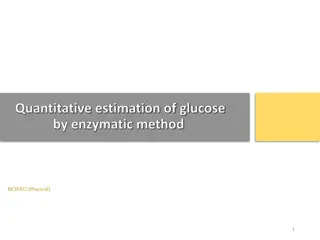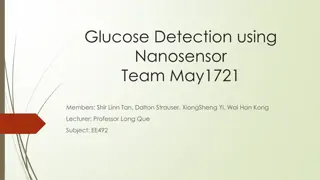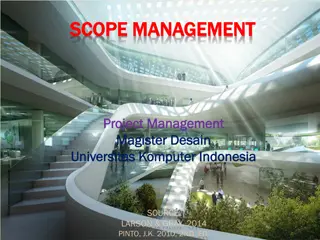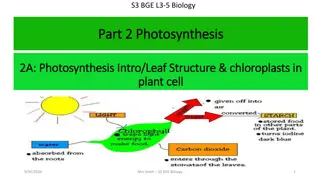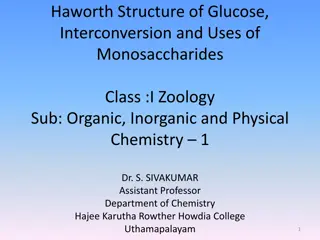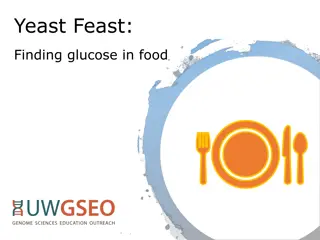Comprehensive Biochemical Tests Training Guide
Enhance your skills in conducting fasting blood glucose, post-prandial glucose, and oral glucose tolerance tests with this comprehensive training guide by Mohammed Al-Zubaidi, PhD. Master the techniques and interpretations for accurate results.
1 views • 42 slides
Understanding Gestational Diabetes: Risk Factors, Diagnosis, and Management
Gestational diabetes is a condition where high blood sugar levels develop during pregnancy in women without pre-existing diabetes. Risk factors include maternal age, family history of diabetes, ethnicity, and obesity. Diagnostic tests involve measuring blood glucose levels, and management includes a
1 views • 15 slides
Understanding Insulin Pump Therapy and Continuous Glucose Monitoring
Exploring the basics of insulin pump therapy, including the basal/bolus concept, operation of insulin pumps, advantages and limitations, day-to-day living with a pump, continuous glucose monitoring, and available systems.
1 views • 45 slides
Blood Glucose Monitoring Devices Market to be Worth $21.71 Billion by 2030
Blood Glucose Monitoring Devices Market by Product (Self-monitoring {Glucometer, Test Strips, Lancets}, Continuous Glucose Monitoring {Sensors, Receiver, Transmitter}), Diabetes Type, End User (Self\/Home Care, Hospital, Clinic) - Global Forecast to 2030.
1 views • 3 slides
Understanding the Seliwanoff Color Reaction and its Significance
The Seliwanoff color reaction, discovered by Russian chemist Feodor Feodorovich Selivanov, is used to differentiate between aldoses and ketohexoses based on their dehydration and reaction with resorcinol in acidic conditions. Ketoses like fructose react faster than aldoses like glucose, leading to a
3 views • 20 slides
Understanding Zener Diodes: Breakdown Mechanisms and Symbol
A Zener diode is a specialized semiconductor device designed to operate in the reverse breakdown region, with two types of breakdown - avalanche and Zener. Avalanche breakdown occurs at high reverse voltages in both normal and Zener diodes, while Zener breakdown is specific to heavily doped P-N junc
9 views • 19 slides
Overview of Glucose Metabolic Pathways in Clinical Chemistry
Explore the major metabolic pathways of glucose, including glycogenolysis, gluconeogenesis, glycolysis, and more. Understand the production, utilization, catabolic, and anabolic cycles of glucose in cellular metabolism. Learn about key concepts such as hexose interconversion, HMP/PPP, Krebs cycle, a
4 views • 29 slides
Case Study: Managing High HbA1c and Normal Fasting Glucose Levels
A case study discusses a 69-year-old woman with a history of stable diabetes facing elevated HbA1c levels despite normal fasting glucose. Initial investigations, including a day curve test, reveal high postprandial glucose levels. The analysis leads to identifying iron deficiency anemia, prompting f
9 views • 22 slides
Best Emergency Breakdown in Guys Hill
Are you looking for the Best Emergency Breakdown in Guys Hill? Then contact Enjoy Towing. They specialise in providing reliable and efficient towing solutions for vehicles of all sizes, from motorcycles to heavy-duty trucks. Their experienced team is available 24\/7 to assist you in roadside emergen
0 views • 6 slides
Understanding Glycolysis: The Initial Step in Glucose Breakdown
Glycolysis, presented by Dr. Madhu Kumari Gupta, is a crucial process in cellular metabolism that involves the breakdown of glucose to extract energy. This pathway occurs in the cytosol and consists of three main phases - an energy-requiring phase, a splitting phase, and an energy-releasing phase. T
0 views • 12 slides
Understanding Cellular Respiration and Oxygen Delivery
Cellular respiration, a vital process for organ survival, involves mitochondria performing cellular respiration by utilizing glucose and oxygen. Glucose is derived from diet or body breakdown, while oxygen enters through the respiratory system, facilitated by red blood cells in the circulatory syste
0 views • 8 slides
Guidelines for Monitoring Blood Glucose in Cancer Patients Undergoing Anti-Cancer Therapy
Guidelines recommend checking HbA1c and random plasma glucose levels at baseline for all cancer patients before initiating anti-cancer therapy. Regular monitoring of plasma glucose levels during treatment is essential, with specific actions based on glucose readings. Immediate referrals and treatmen
0 views • 4 slides
Understanding Photosynthesis: Process, Importance, and Stages
Photosynthesis is a vital process where plants make their own food using carbon dioxide, water, and light energy. It plays a crucial role in producing oxygen, removing carbon dioxide from the air, and forming fossil fuels. The balanced equation for photosynthesis shows how glucose and oxygen are pro
0 views • 34 slides
Dairy Plant Maintenance: Strategies for Preventive and Breakdown Care
Preventive and breakdown maintenance of dairy plants is essential to ensure continuous production and quality control. Dr. J. Badshah, a renowned expert in dairy engineering, explains the importance of corrective and preventive actions, scheduling maintenance tasks, identifying root causes of defect
0 views • 18 slides
Understanding Blood Glucose Control Mechanisms in the Human Body
This content explores the regulation of blood glucose levels in the human body, covering the role of hormones like insulin and glucagon produced by the pancreas. It discusses the importance of maintaining proper blood glucose levels and the consequences of levels being too high or too low. The text
0 views • 19 slides
Managing Blood Sugar Levels at Home for Low/No Vision
Explore the importance of monitoring blood glucose levels at home for individuals with low/no vision, learn about talking blood glucose meters, and make continuous glucose monitors accessible. Understand why maintaining blood sugar levels is crucial to prevent complications in diabetes, and get tips
2 views • 25 slides
Guidelines for Managing Hyperglycemia in Cancer Patients Receiving Anti-Cancer Therapy
Cancer patients undergoing anti-cancer therapy need vigilant monitoring for hyperglycemia. Baseline HbA1c and random plasma glucose levels must be checked before initiating therapy. Regular glucose monitoring, symptom assessment, and ketone testing are crucial throughout treatment. Prompt referrals,
0 views • 4 slides
Electrical Breakdown in Gases, Solids, and Liquids: Understanding the Phenomenon
Exploring the intricate dynamics of electrical breakdown in various mediums such as gases, solids, and liquids. From the criteria for breakdown in gases to factors affecting breakdown strength in liquid dielectrics, this study delves into the mechanisms, equations, and practical implications of thes
0 views • 15 slides
Quantitative Estimation of Glucose by Enzymatic Method in Blood Samples
Estimation of blood glucose levels is crucial for diagnosing and managing conditions like diabetes mellitus. This practical involves using the enzymatic method with glucose oxidase to quantitatively determine glucose levels in serum. The enzymatic reaction converts glucose to gluconic acid and hydro
0 views • 8 slides
Epimerisation of D-Glucose into D-Mannose: Structural Insights
Explore the fascinating process of epimerisation, specifically the conversion of D-glucose into D-mannose. Discover the limitations of open chain structures, the ring structure of glucose, and the evidence supporting it. Learn about the stereochemistry of D-glucose, optical rotation, and the equilib
0 views • 13 slides
Understanding P-N Junction Diodes and Zener Diodes
A normal p-n junction diode allows electric current only in forward biased condition, offering small resistance. When reverse biased, it blocks current. If the reverse biased voltage is highly increased, it can lead to zener or avalanche breakdown. Zener diodes are specifically designed for working
0 views • 19 slides
The Importance of Glycogen in Providing a Constant Source of Blood Glucose
Glycogen serves as a crucial storage form of glucose in the body, ensuring a constant source of blood glucose crucial for brain function, RBC energy, and muscle fuel. This storage form is essential for providing glucose during times of fasting or increased energy demands, with glycogen synthesis and
0 views • 28 slides
Understanding Glycogenolysis in Vertebrates: A Detailed Overview
In vertebrates, glycogen serves as a glucose reservoir in the liver and skeletal muscles. Glycogenolysis is the breakdown of glycogen into glucose-6-phosphate, crucial for providing glucose to tissues in the absence of dietary sources. Enzymes like glycogen phosphorylase, debranching enzyme, and pho
0 views • 13 slides
Update on Diabetic Ketoacidosis (DKA) Guidelines by UHB and JBDS
There has been a recent update in the Diabetic Ketoacidosis (DKA) guidelines by UHB and JBDS. The new guidelines include reducing the insulin infusion rate to 0.05 units/kg/hr once blood glucose levels reach 14mmol/l. Additionally, alongside a 10% glucose administration of 125ml/hr is recommended to
1 views • 12 slides
Regulation of Blood Glucose and Its Importance in Maintaining Health
Blood glucose regulation is crucial for energy supply in the body, particularly for brain function. Understanding the balance of glucose entering and leaving the blood through processes like absorption, glycogenolysis, and gluconeogenesis is vital. Hormones like insulin and glucagon play key roles i
0 views • 10 slides
Understanding Glucose Homeostasis in Metabolic Processes
Glucose homeostasis is crucial for controlling glucose metabolism and maintaining normal blood glucose levels in the body. It involves various metabolic sources, including dietary intake and gluconeogenesis. The liver plays a vital role in regulating blood glucose levels, while severe hypo- and hype
0 views • 17 slides
Analyzing the Impact of Glucose on Students' Listening Span
Research presented by Dr. Christine Malone explores how drinking glucose can enhance listening span in students who miss breakfast. The study investigates if the experiment qualifies as a true experiment by analyzing key features like manipulation, measurement, comparison, and control. Internal vali
1 views • 12 slides
Analysis of NGC Base HV Breakdown Study and Voltage Divider Diagram
The NGC Base HV breakdown study identifies potential workmanship issues affecting sparking in a 60% Neon-40% Argon atmosphere near +2000V. Recommendations include checking and redoing signal and ground attachments, along with hi-potting HV cables to 3000V. Switching to 60% Neon/40% Argon prompts a c
1 views • 14 slides
Understanding Zener Diodes and Breakdown Characteristics
Zener diodes play a crucial role in electronic circuits by allowing current flow in both forward and reverse biased conditions. When reverse biased voltage is applied, zener diodes exhibit a unique behavior called breakdown, where a sudden rise in current occurs leading to zener voltage and zener cu
0 views • 21 slides
Understanding Zener Diodes in Analog Electronics
Zener diodes are heavily doped semiconductor devices designed to operate in reverse bias conditions. They exhibit the Zener effect where breakdown occurs, allowing current flow in the reverse direction. These diodes maintain a constant voltage (Zener voltage) across them, making them useful as volta
3 views • 12 slides
Disposable Glucose Nanosensor Development Project
This project aims to develop a disposable glucose nanosensor and testing method to detect a range of concentrations. The goal is to create a low-cost and easy-to-fabricate nanosensor by designing an effective fabrication process. Steps involve cleaning the microscope slide, depositing titanium and a
0 views • 14 slides
Understanding Glycaemic Index in Nutrition and Health
Glycaemic Index (GI) measures how carbohydrate-containing foods affect blood glucose levels. High GI foods raise blood glucose rapidly, while low GI foods release glucose gradually. Studies track impacts on blood glucose levels, insulin secretion, fat storage, and pancreatic function. High GI foods
0 views • 15 slides
Breakdown Test of SW Accelerator Cavity with Shaped Iris
In a study by J.M. Neilson, V. Dolgashev, and S. Tantawi at SLAC National Accelerator Laboratory, planned breakdown tests were conducted on a single-cell SW accelerator cavity with shaped iris geometries. The research assessed breakdown dependence, different iris parameters, and compared elliptical
0 views • 10 slides
Understanding Work Breakdown Structure at The Ohio State University
Work Breakdown Structure (WBS) is a hierarchical description of all work needed to meet customer requirements. This includes examples such as organizing conferences and acquiring data for projects. The provided visual aids showcase the breakdown of tasks involved in different scenarios, highlighting
0 views • 20 slides
Project Scope Management in Project Management
Project scope management is crucial for controlling a project and ensuring its goals and objectives are met. It involves defining project objectives, deliverables, milestones, technical requirements, and establishing priorities. By creating a hierarchical breakdown of the work breakdown structure (W
0 views • 12 slides
Perioperative Glucose Control in Diabetes Management
Managing perioperative glucose levels is crucial for patients with diabetes to prevent complications and improve outcomes. This case-based scenario discusses strategies for perioperative glucose control in different diabetic patients, emphasizing the importance of monitoring and individualized treat
0 views • 47 slides
Understanding the Role of Glucose in Photosynthesis
Exploring how plants use glucose produced during photosynthesis, including its various uses such as providing energy, being stored as starch, and contributing to the formation of plant cell walls and other essential chemicals. The process of photosynthesis, the fate of glucose, and the conversion of
0 views • 11 slides
Exploring Project Modelling and Work Breakdown Structures
In project management, precise project definition is crucial for successful planning and control. Project modelling involves utilizing tools like Work Breakdown Structure (WBS) to efficiently define project scopes and hierarchies. By breaking down the project into smaller elements of work, WBS aids
0 views • 37 slides
Uses and Conversions of Glucose and Fructose in Chemistry
Glucose and fructose have various uses, including as food for patients and in confectionery. Glucose is also used in silvering mirrors, processing tobacco, and starting material for vitamin C synthesis. Fructose is a sweetening agent and a sugar substitute. Glucose can be converted into fructose thr
0 views • 10 slides
Understanding Glucose and Its Role in the Body
Delve into the significance of glucose as a primary energy source in our diets, the various sources of glucose in food, and the enzymes involved in breaking down sugars. Explore the connection between glucose and type 2 diabetes, emphasizing the importance of maintaining healthy blood glucose levels
0 views • 10 slides


















